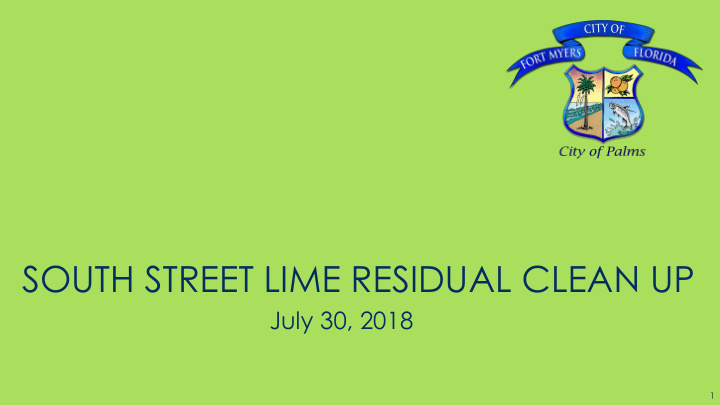



SOUTH STREET LIME RESIDUAL CLEAN UP July 30, 2018 1
APPROXIMATELY 20,000 CUBIC YARDS (30,000 TONS) OF LIME RESIDUAL DEPOSITED ON PROPERTY IN THE EARLY 60’S 2
BACKGROUND January 16, 2018 – Council Workshop Conclusions of Environmental Assessment: Source of arsenic in groundwater is not lime residual. Arsenic concentrations in standing water pose no risk. Arsenic concentrations in residual do not pose a short- or long-term health concern to people in the surrounding neighborhood. Options presented to City Council: No further action. Provide a cap (concrete, asphalt, soil) over the lime residual. Remove & replace the top 2’ of lime residual and stabilize. Completely remove & replace the lime residual. 3
DISPOSAL INVESTIGATIONS City Staff investigated several options for the disposal of the Lime Residual from the site. Options included: Land Application at an Agricultural Facility: Prolonged removal time frame and public reaction. Disposal at Land Fill: Limited quantities per day allowed at land fill. Prolonged removal time frame. Mix with other materials for Road Base: Requires large amount of other materials and prolonged removal time frame. Reuse in Manufacturing Processes: Meets time frame requirements. High cost of transportation. 4
OPTIONS OPTION 1: Remove Lime Residual create stormwater pond and park. Monthly groundwater monitoring throughout the lime removal process. Option 2: Remove Lime Residual and Back Fill for development. Monthly groundwater monitoring throughout the lime removal process. Option 3: Leave Lime Residual in place and provide minimum 2’of soil. Use property as a park. Long term groundwater monitoring. 5
OPTIONS 1 & 2 Lime Residual Removal Processes: 1. Acquire Right of Entry Authorizations from private properties. 2. Site Preparation - Removal of all vegetation and organic debris within the site confines. Relocate fence to ROW to include private properties. 3. Excavation/Removal- Investigate private properties to ensure that there is no lime residual on these properties. Remove residual if found. Excavate lime residual from pits following FDEP approved protocols. Confirmation monitoring to ensure complete removal. 4. Disposal - The City is contracting with a disposal company that will take ownership and responsibility of the lime residual as soon as it’s loaded at the site. The lime residual will be transported to a concrete and ceramics Company that will utilize it in their manufacturing process. 6
LIME REMOVAL PLAN 7
OPTIONS 1 & 2 Lime Residual Removal Costs Site Preparation - Clearing - $ 325,000 Fence* - $ 15,000 Excavation/ Removal - $ 325,000 Monitoring - $ 193,000 Disposal - $3,200,000 Subtotal $4,058,000 10% Contingency $ 405,800 TOTAL $4,463,800 * Includes relocating fence back to current configuration after completion. 8
OPTION 1 RECLAMATION Create stormwater pond utilizing sheet pile installed during the excavation with a cap and handrail. Pond to be designed to maximize water treatment and attenuation of run-off while providing a neighborhood park facility. Will require a minimum of fill to be brought back into the site reducing the reclamation costs. Allows for the redesign of the City View Stormwater Management System to reduce flooding in the area. Can be used to provide a nitrogen reduction of approximately 65 lb/year that can be applied to the Basin Management Action Plan reductions that the City has committed to with FDEP. 9
POTENTIAL OPTION 1 PLAN 10
OPTION 2 - RECLAMATION Requires approximately 30,500 cubic yards of fill material to be imported on the site. Allows for the property to be utilized for any purpose in the future. 11
POTENTIAL OPTION 2 PLAN 12
OPTION 3 Soil Capping Processes: Acquire Right of Entry Authorizations from private properties. Site Preparation - Removal of all trees within the site confines. Relocate fence to ROW to include private properties. Capping- Investigate private properties to ensure that there is no lime residual on these properties within the upper two feet. Spread and compact approximately 9,500 cubic yards of fill over the lime residual areas. Monitoring – Long term groundwater monitoring will be required if this option is utilized. The capping of the site serves as the reclamation for this option. The site may be used as a passive park. 13
POTENTIAL OPTION 3 PLAN 14
COST COMPARISON ACTIVITY OPTION 1 OPTION 2 OPTION 3 Removal $4,463,800 $4,463,800 $ 150,000* Reclamation Import Fill $ 25,200 $ 768,600 $ 239,400 Park Facilities $ 85,000 NA $ 140,000 SWM Lake Design and construction** $ 50,000 NA NA 10% contingency $ 16,020 $ 76,860 $ 37,940 Subtotal $ 176,220 $ 845,460 $ 417,340 Total $4,640,020 $5,309,260 $ 567,340 + $27,500 annual monitoring cost *Tree and stump removal, fence removal, and verify no lime residual in upper two feet of private properties. ** Does not include neighborhood SWM design and construction 15
STAFF RECOMMENDATION Staff recommends Option 1 for the Lime Residual Removal Option 1 will: Remove the lime residual and eliminate future public concerns. Provide an opportunity to alleviate flooding in the neighborhood. Provide a neighborhood park which will increase the surrounding property values. Provide a water quality feature that will improve the surface water discharges to Billy Creek. 16
Recommend
More recommend